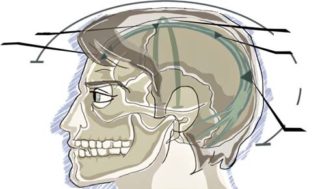Could Craniometric Measurements Explain the Growth of the Superior Sagittal Sinus?
Rodrigo Becco de Souza Fernando Campos Gomes Pinto
Death Verification Service, University of Sao Paulo, Sao Paulo , Brazil
Key Words
Superior sagittal sinus · Skull · Craniometry · Cephalometry
Abstract
Objective: The objective of this study was to relate demographic variables and craniometric measures with measurements of the superior sagittal sinus (SSS) at different points along the path of the SSS. The findings were then discussed with regards to theories of skull growth. Methods: We studied 33 skulls with known demographic characteristics and measured various craniometric parameters and distances related to the specific dimensions of the SSS. These data were statistically analyzed, and the results are presented.

Results: Of the 33 cadaver samples, 16 were female and 17 were male, aged between 28 and 87 years at the time of death. The cross-sectional area of the SSS measured at the coronary suture was positively correlated with the biauricular length. In addition, when measured 1.5 cm above the torcula, the cross-sectional area of the SSS was negatively correlated with the distance between the medial epicanthi.
Conclusions: The relationships found may indicate that the growth of the SSS is proportional to the activity of each segment of the SSS that occurs along its path.
Introduction
Surface drainage of the brain is carried out by four groups of veins: the superior sagittal, sphenoidal, tentorial and falcine veins. The superior sagittal sinus (SSS) is responsible for draining the veins of the superior sagittal group, which consists of veins from the upper surfaces of the medial and lateral frontal lobe, the parietal and occipital lobes, and the anterior part of the orbital surface of the frontal lobe [1] .
The SSS progresses along the midline, lateralized to the right relative to the sagittal suture [2] . It starts behind the frontal sinus and becomes larger as it traverses from anterior to posterior along the inner table of the skull. It then drains into the transverse sinus at the confluence of sinuses [1] which connects the SSS, transverse sinuses, straight sinus and occipital sinus.
The SSS is closely related to the dura mater (DM), sagittal suture and skull; however, little is known about the correlation between the growths of these structures. The aim of this paper was to utilize cadavers to relate craniometric measures with measures of the SSS at different points in its path and to discuss the findings with respect to theories of skull growth.
Dr. Rodrigo Becco
Médico neurocirurgião graduado pela Universidade de São Paulo (USP), em 2007. Residente em Neurocirurgia pela Santa Casa de São Paulo, em 2014. Mestre pelo Instituto de Assistência Médica do Servidor Público Estadual, em 2015. Membro da Sociedade Brasileira de Neurocirurgia desde 2014.

